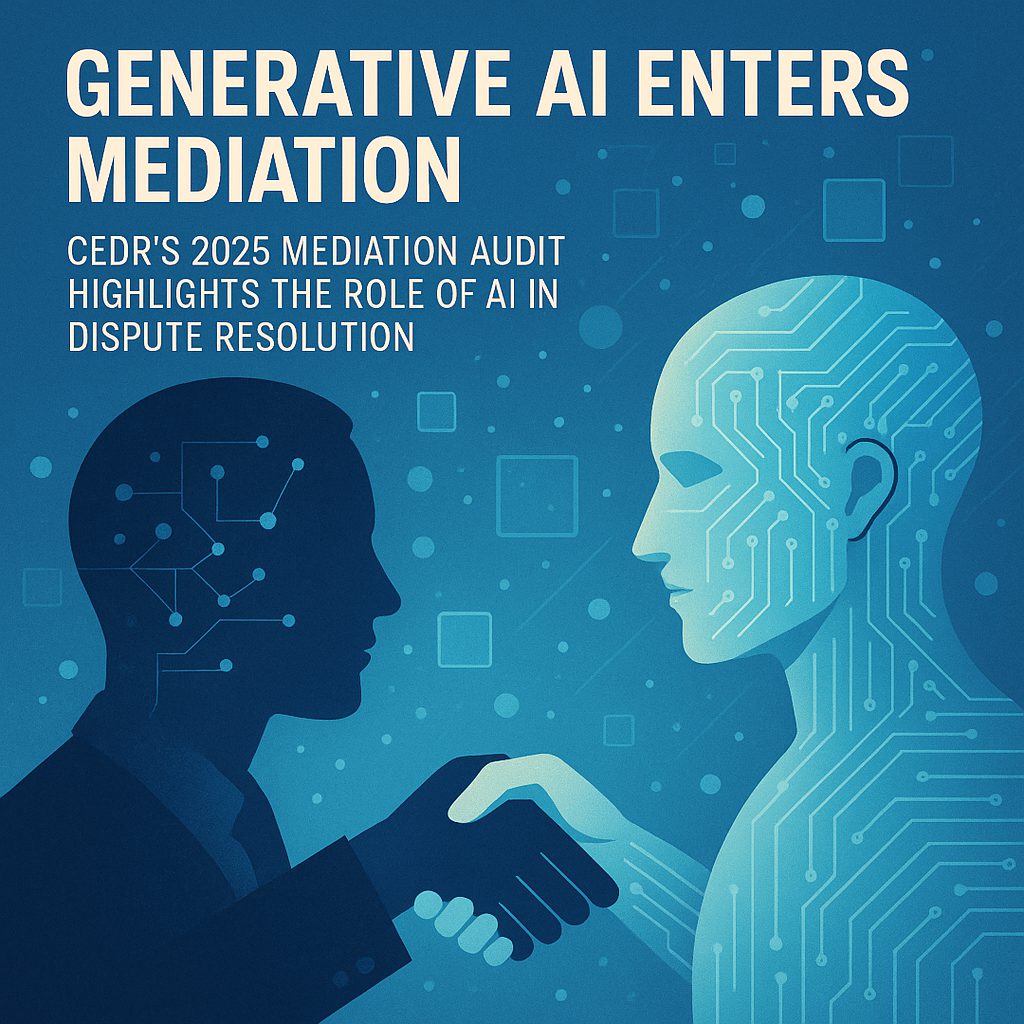
AI Finally Arrives in CEDR’s 2025 Mediation Audit
For more than two decades, the CEDR Mediation Audit has set the benchmark for understanding the state of the mediation market. Each edition captures how mediators are working, how the profession is developing, and what the future might hold.
Back in 2023, one absence was striking: not a single mention of Artificial Intelligence. While other industries were grappling with how AI could reshape their future, mediation appeared to be looking the other way.
Fast forward to 2025, and the picture has changed. The Eleventh Mediation Audit has, at last, acknowledged the elephant in the room: generative AI is here, and it will have consequences for mediation.
What the Audit Says About AI
The 2025 Audit doesn’t just nod towards AI; it signals a meaningful shift in tone. Several themes emerge:
- Judicial support for GenAI. The Audit quotes Sir Geoffrey Vos, Master of the Rolls, who has spoken positively about the potential of generative AI in dispute resolution. With the volume and complexity of data involved in many cases, GenAI may become an essential tool for supporting fair and efficient outcomes.
- AI is not a replacement. The Audit stresses that AI cannot be relied upon as an independent authority. Human oversight is non-negotiable. Mediators need to interrogate and contextualise AI outputs rather than defer to them.
- A tipping point for accessibility. Simpler, lower-value disputes may soon be resolved through AI-enabled platforms (though in my experience lower-value does not necessarily mean simpler), making mediation more scalable and affordable. This prospect is not about displacing mediators but about extending access to services that remain out of reach for many.
- Trust and transparency matter. The Audit highlights a concern that cannot be brushed aside: if AI is to play a role in mediation, mediators must maintain clarity about how data is handled, how AI is used, and where its limits lie. Clients will only accept AI-assisted processes if they believe confidentiality and fairness are protected.
Why This Matters
The fact that CEDR has included AI in its Audit is more than a passing comment, it marks a mainstreaming moment.
Two years ago, the idea that mediation could meaningfully involve AI was barely being voiced in formal industry reporting. Today, it is being positioned as both an opportunity and a challenge. That tells us something important: AI is no longer an abstract debate for tech enthusiasts; it’s a live issue for dispute resolution professionals.
But the Audit also reveals something else: mediation, as a profession, is still cautious. The language is measured, the warnings are emphasised, and the conversation remains framed as something that may affect us in the future. In reality, AI is already shaping how legal and commercial disputes are managed. The question is not whether mediation will adapt, but how quickly.
From Silence to Strategy
This shift from silence (in 2023) to recognition (in 2025) is encouraging. Yet recognition alone isn’t enough. For mediators, the challenge now is to move beyond curiosity and into practical engagement.
What does that mean in practice?
- Learning how AI tools can support case preparation and streamline routine tasks.
- Understanding the risks – bias, inaccuracy, lack of nuance – and how to mitigate them.
- Exploring how AI can broaden access to mediation, without undermining its human core.
In other words: we need to stop asking whether AI belongs in mediation and start building the skills and frameworks that ensure it adds value.
Our Contribution: AI for Mediators
At both Hunt ADR and Business AI Studio, I and others have been working on this question for some time. It’s why we launched the podcast No Disputing That, where I’ve recently discussed the role of AI in mediation. It’s also why we’ve developed our new training programme: AI for Mediators.
This course, led and designed by me and Kelly Thornton, is not designed not to dazzle mediators with technology, but to give them practical, ethical, and strategic tools for integrating AI into their work. Participants will learn:
- How to use AI effectively in case management and preparation.
- The limits of AI, and how to apply professional judgement to AI outputs.
- Ways in which AI can expand access to mediation without eroding trust.
- Ethical considerations that ensure mediators remain accountable and transparent.
We believe that AI should be seen not as a threat to the profession but as a support. Done right, it can make mediation more efficient, more accessible, and more relevant in a changing world.
A Call to Action
The 2025 CEDR Audit is a milestone. It confirms that AI has entered the mediation conversation at last. But the real work starts now. Mediators cannot afford to sit back and wait for the profession to decide how AI should be used. We must lead the conversation, shape the standards, and develop the skills to use these tools responsibly.
At Hunt ADR we’re proud to be at the forefront of that work. Through No Disputing That and our AI for Mediators training, we’re inviting the profession to step into the future – with clarity, confidence, and purpose.
Listen to episode 26 of No Disputing That in which I discuss AI for ADR Professionals.
Read more about our new course, Practical Skills for the Modern Mediator (and the use of AI).
Mediation’s future is already being written. AI is part of the story. The only question is whether mediators choose to be authors or bystanders.
